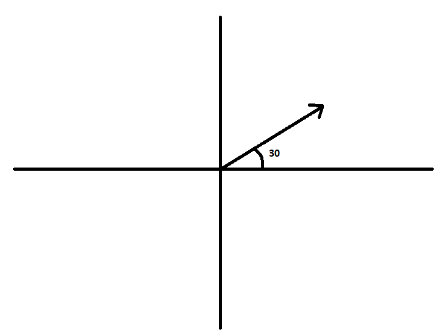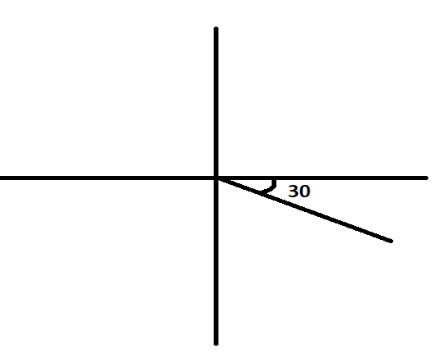
Answer
480.3k+ views
Hint: If a unit vector is making an angle $\theta $ with the positive direction of x-axis, then it’s component along the x-axis is $\cos \theta $ and it’s component along the positive y-axis is $\sin\theta $. This unit vector will be written as $\cos \theta \widehat{i}+\sin \theta \widehat{j}$.
Before proceeding with the question, we must know the formula that will be required to solve this question. In vectors, if a unit vector is making an angle $\theta $ with the positive x-axis, then the vector can be written as $\cos \theta \widehat{i}+\sin \theta \widehat{j}$. The x component of this vector is $\cos \theta $ and the y component of this vector is $\sin \theta $.
In the question, we have to write down the unit vector making an angle ${{30}^{\circ }}$ with the positive x-axis.

The x component of this vector will be $\cos {{30}^{\circ }}$ and the y component of this vector will be $\sin {{30}^{\circ }}$. So, this unit vector which is making an angle ${{30}^{\circ }}$ with the positive x-axis can be written as \[\cos {{30}^{\circ }}\widehat{i}+\sin {{30}^{\circ }}\widehat{j}\].
From trigonometry, we have $\cos {{30}^{\circ }}=\dfrac{\sqrt{3}}{2}$ and $\sin {{30}^{\circ
}}=\dfrac{1}{2}$. Substituting these values in the above vector, we get,
$\dfrac{\sqrt{3}}{2}\widehat{i}+\dfrac{1}{2}\widehat{j}$
There is one more possible vector that can make an angle of ${{30}^{\circ }}$ with the positive x-axis.
That vector is as shown below,

The x component of this vector will be $\cos {{30}^{\circ }}$ and the y component of this vector will be $\sin {{30}^{\circ }}$. But in this vector, the y component will be along the negative y-axis. So, this unit vector which is making an angle ${{30}^{\circ }}$ with the positive x-axis can be written as
\[\cos {{30}^{\circ }}\widehat{i}-\sin {{30}^{\circ }}\widehat{j}\].
From trigonometry, we have $\cos {{30}^{\circ }}=\dfrac{\sqrt{3}}{2}$ and $\sin {{30}^{\circ
}}=\dfrac{1}{2}$. Substituting these values in the above vector, we get,
$\dfrac{\sqrt{3}}{2}\widehat{i}-\dfrac{1}{2}\widehat{j}$
So, the two possible answers are $\dfrac{\sqrt{3}}{2}\widehat{i}+\dfrac{1}{2}\widehat{j}$ and $\dfrac{\sqrt{3}}{2}\widehat{i}-\dfrac{1}{2}\widehat{j}$.
Note: In this question, we were given a unit vector which is making an angle of ${{30}^{\circ }}$ with the positive x-axis. We wrote this vector by using the formula $\cos \theta \widehat{i}+\sin \theta \widehat{j}$. But in case we are given a vector which is also having a magnitude, let us say $r$and making an angle $\theta $ with the positive x-axis, we will write that vector by using the formula
$r\left( \cos \theta \widehat{i}+\sin \theta \widehat{j} \right)$.
Before proceeding with the question, we must know the formula that will be required to solve this question. In vectors, if a unit vector is making an angle $\theta $ with the positive x-axis, then the vector can be written as $\cos \theta \widehat{i}+\sin \theta \widehat{j}$. The x component of this vector is $\cos \theta $ and the y component of this vector is $\sin \theta $.
In the question, we have to write down the unit vector making an angle ${{30}^{\circ }}$ with the positive x-axis.

The x component of this vector will be $\cos {{30}^{\circ }}$ and the y component of this vector will be $\sin {{30}^{\circ }}$. So, this unit vector which is making an angle ${{30}^{\circ }}$ with the positive x-axis can be written as \[\cos {{30}^{\circ }}\widehat{i}+\sin {{30}^{\circ }}\widehat{j}\].
From trigonometry, we have $\cos {{30}^{\circ }}=\dfrac{\sqrt{3}}{2}$ and $\sin {{30}^{\circ
}}=\dfrac{1}{2}$. Substituting these values in the above vector, we get,
$\dfrac{\sqrt{3}}{2}\widehat{i}+\dfrac{1}{2}\widehat{j}$
There is one more possible vector that can make an angle of ${{30}^{\circ }}$ with the positive x-axis.
That vector is as shown below,

The x component of this vector will be $\cos {{30}^{\circ }}$ and the y component of this vector will be $\sin {{30}^{\circ }}$. But in this vector, the y component will be along the negative y-axis. So, this unit vector which is making an angle ${{30}^{\circ }}$ with the positive x-axis can be written as
\[\cos {{30}^{\circ }}\widehat{i}-\sin {{30}^{\circ }}\widehat{j}\].
From trigonometry, we have $\cos {{30}^{\circ }}=\dfrac{\sqrt{3}}{2}$ and $\sin {{30}^{\circ
}}=\dfrac{1}{2}$. Substituting these values in the above vector, we get,
$\dfrac{\sqrt{3}}{2}\widehat{i}-\dfrac{1}{2}\widehat{j}$
So, the two possible answers are $\dfrac{\sqrt{3}}{2}\widehat{i}+\dfrac{1}{2}\widehat{j}$ and $\dfrac{\sqrt{3}}{2}\widehat{i}-\dfrac{1}{2}\widehat{j}$.
Note: In this question, we were given a unit vector which is making an angle of ${{30}^{\circ }}$ with the positive x-axis. We wrote this vector by using the formula $\cos \theta \widehat{i}+\sin \theta \widehat{j}$. But in case we are given a vector which is also having a magnitude, let us say $r$and making an angle $\theta $ with the positive x-axis, we will write that vector by using the formula
$r\left( \cos \theta \widehat{i}+\sin \theta \widehat{j} \right)$.
Recently Updated Pages
How many sigma and pi bonds are present in HCequiv class 11 chemistry CBSE

Mark and label the given geoinformation on the outline class 11 social science CBSE

When people say No pun intended what does that mea class 8 english CBSE

Name the states which share their boundary with Indias class 9 social science CBSE

Give an account of the Northern Plains of India class 9 social science CBSE

Change the following sentences into negative and interrogative class 10 english CBSE

Trending doubts
Fill the blanks with the suitable prepositions 1 The class 9 english CBSE

The Equation xxx + 2 is Satisfied when x is Equal to Class 10 Maths

In Indian rupees 1 trillion is equal to how many c class 8 maths CBSE

Which are the Top 10 Largest Countries of the World?

How do you graph the function fx 4x class 9 maths CBSE

Give 10 examples for herbs , shrubs , climbers , creepers

Difference Between Plant Cell and Animal Cell

Difference between Prokaryotic cell and Eukaryotic class 11 biology CBSE

Why is there a time difference of about 5 hours between class 10 social science CBSE



